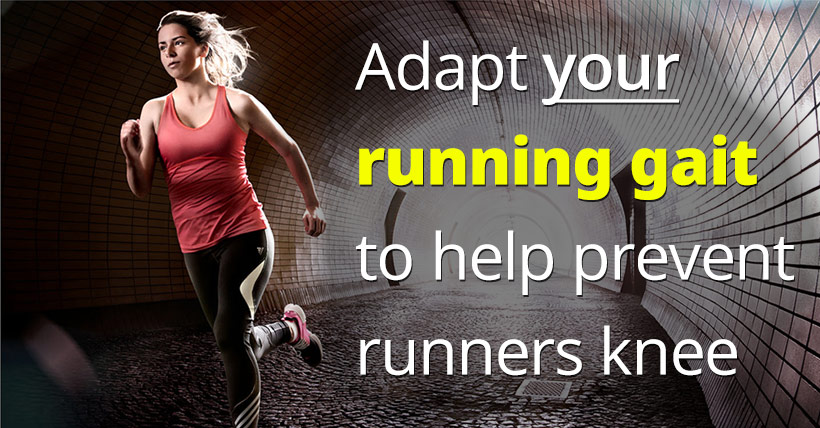Retraining your gait to help prevent runners knee

Patellofemoral Pain Syndrome, otherwise known as Runner’s Knee is still the most common injury amongst runners today. Many aspects of this injury have been looked at however today we’ve decided to look at ways of adapting your gait to help prevent this syndrome. It must be remembered however that running style is very much an individual thing. There’s no one correct way to run and each runner will have undoubtedly developed a gait that feels comfortable to them. Changing of your running gait should certainly be carried out with caution.
A key concept in runners knee is very much about reducing the load going through the patellofemoral joint (where the femur meets the tibia forming the main knee joint) during your run. This will reduce the pain and there are a number of ways to do this. Today we’ll look at just two ways and we’ll categorise them into two groups titled the easy way and the hard way. We’ll begin by looking at the easy way.
The Easy Way
The easy way to reduce patellofemoral load during running is to increase your step rate and reduce your stride length and it’s a lot easier than it sounds. Step rate and stride length are actually rather intimately linked; if you increase your amount of strides, your stride length will naturally reduce. There have been three recent studies that showed a number of benefits to a higher step rate and smaller stride length. Benefits included a reduced load on the hip and knee joints ultimately reducing the risk of stress fractures and patellofemoral pain. An altered posture at foot-ground contact was also noted which showed increased knee flexion, a lower incline of the foot and a heel that was further under the bodies centre of mass. Lastly a change in hip position and glute activation was seen which reduced hip adduction and increased the activation of the gluteus in anticipation of foot-ground contact. During the studies a metronome was used to help runners increase their step rate by roughly 10%, which was enough to have significant effects without negatively affecting their performance. A metronome can be easily downloaded onto an MP3 player however you will need the help of one of our qualified physiotherapists to determine your current step rate and workout your target. There is always the option of simply running and if pain starts try increasing your step rate. Find a rate and stride that feels comfortable to you.
The Hard Way
The harder way to change your running style to help with runners knee is to reduce hip adduction and internal rotation angles during the impact phase, or in other words…become a woman. Allow us to explain. A study in 2011 treated eleven runners, all of which were women. All of these women had excess hip adduction (when the leg is brought back) during their running gait. Using 3D gait analysis they guided these women into altering their gait and the results were excellent. Sadly as promising as this all sounds, when you delve a little deeper into any study you’ll always usually come across a stumbling block. The study began with 170 participants and only 11 were found to suffer from excessive hip adduction thus qualifying for the study. As mentioned before, all of these subjects were women which begs the question, what about the men? It’s possible that this study simply suggests excessive hip adduction is more common in women and is something that can be corrected through gait re-training. It also suggests that with careful assessment, we are able to identify runners that would benefit from custom-made interventions. Here at City Rehab we’re very much fans of the tailored approach rather than the one size fits all as this just doesn’t account for individual differences. The reason this is considered the hard way is simply down to the equipment needed such as a 3D motion analysis system.
There is another method that more runners are now trying, a much more natural method and that’s barefoot running. In a recent study, barefoot running was seen to reduce the load on the patellofemoral joint however it was noted that it increased the load on the calf complex. Barefoot runners were seen to have a much shorter stride, which could be the key factor in the reported reduction in knee load. It must be remembered however that there are of course limits to what we can conclude from research.
In summary, patellofemoral pain is known to be a problem with many different factors and one of those is running gait. Altering your running gait may very well help symptoms and the easiest way to achieve this is by increasing the step rate and reducing the stride length, thus finding a comfortable style. It must be remembered however that with a multifactorial problem, a multimodal approach is often required and in order to get the best result possible, a professional should be approached. It’s therefore important to seek help when considering something as important as a gait change and whatever changes you make should be based on the detailed individual assessment from a qualified physiotherapist. If you’d like help with runners knee or any other sports injury you may be suffering from then please don’t hesitate to contact us today. Here at City Rehab, our highly qualified physiotherapists will have you on the road to recovery in no time at all.

